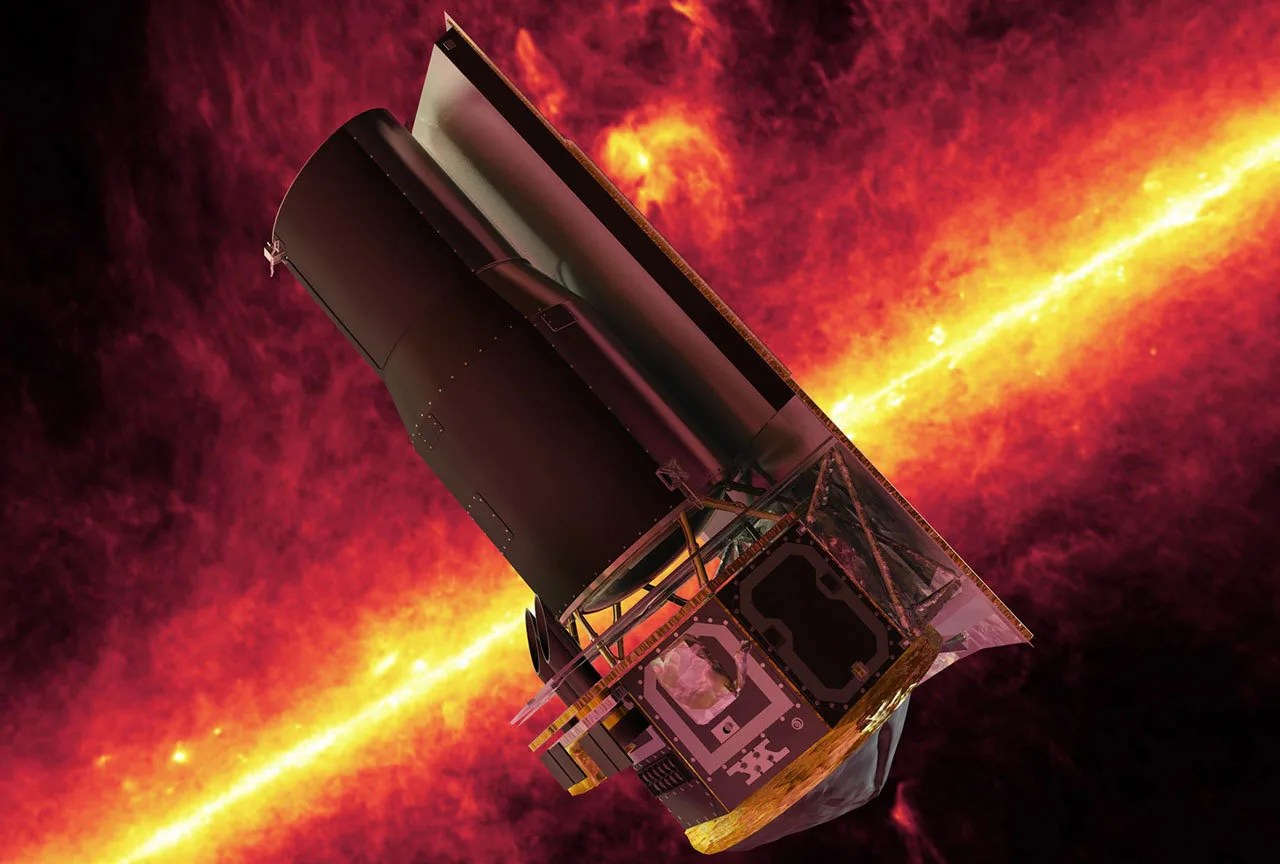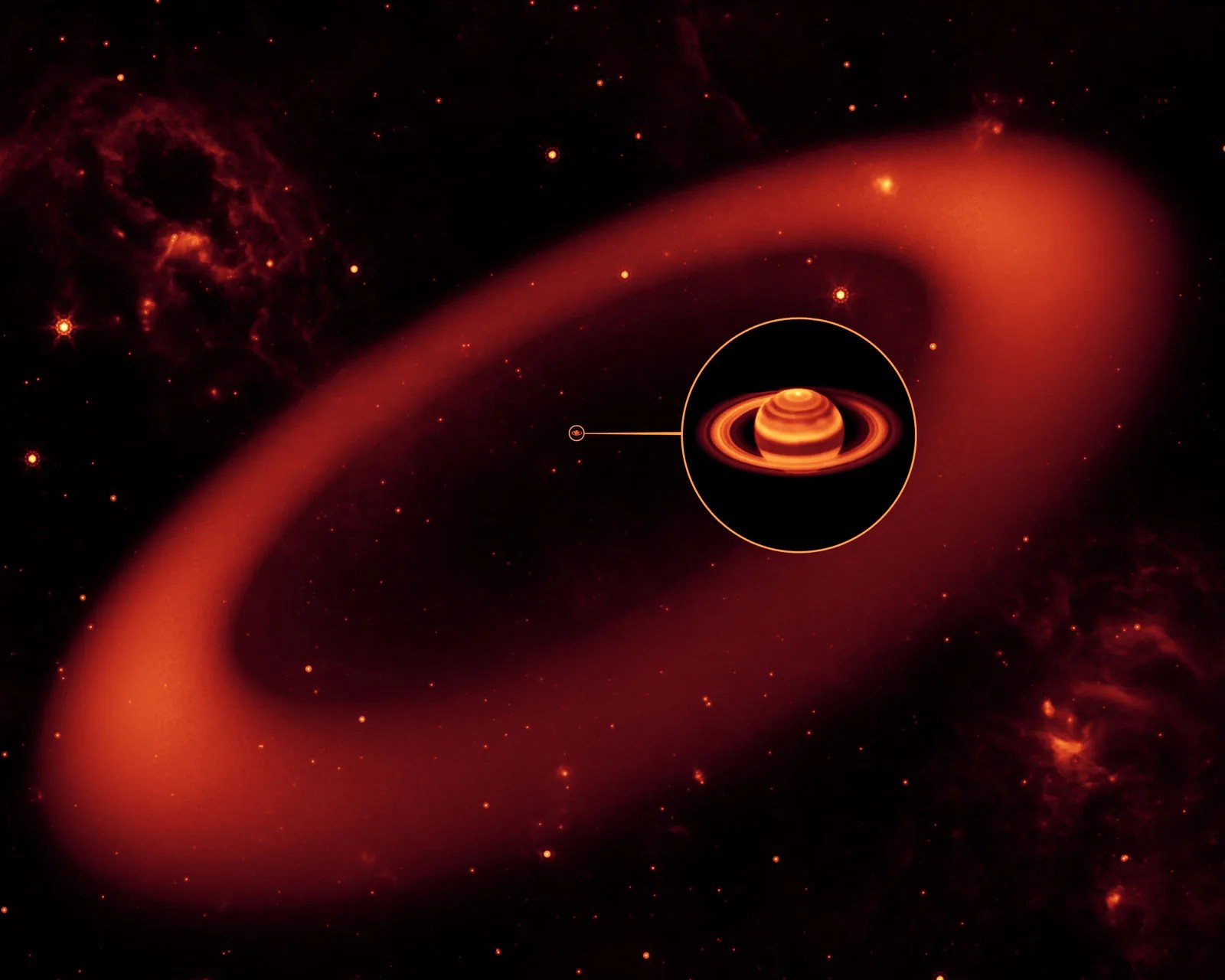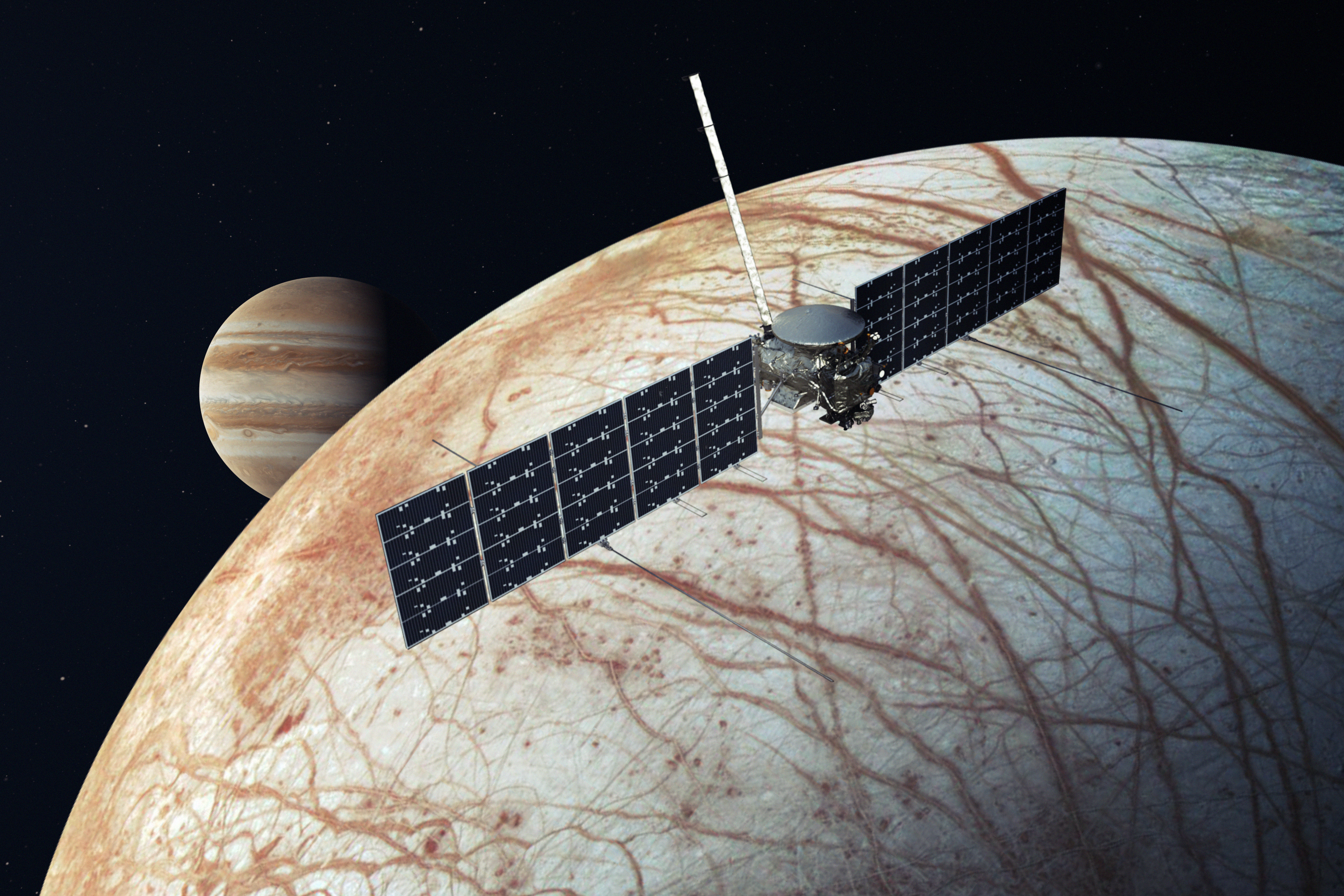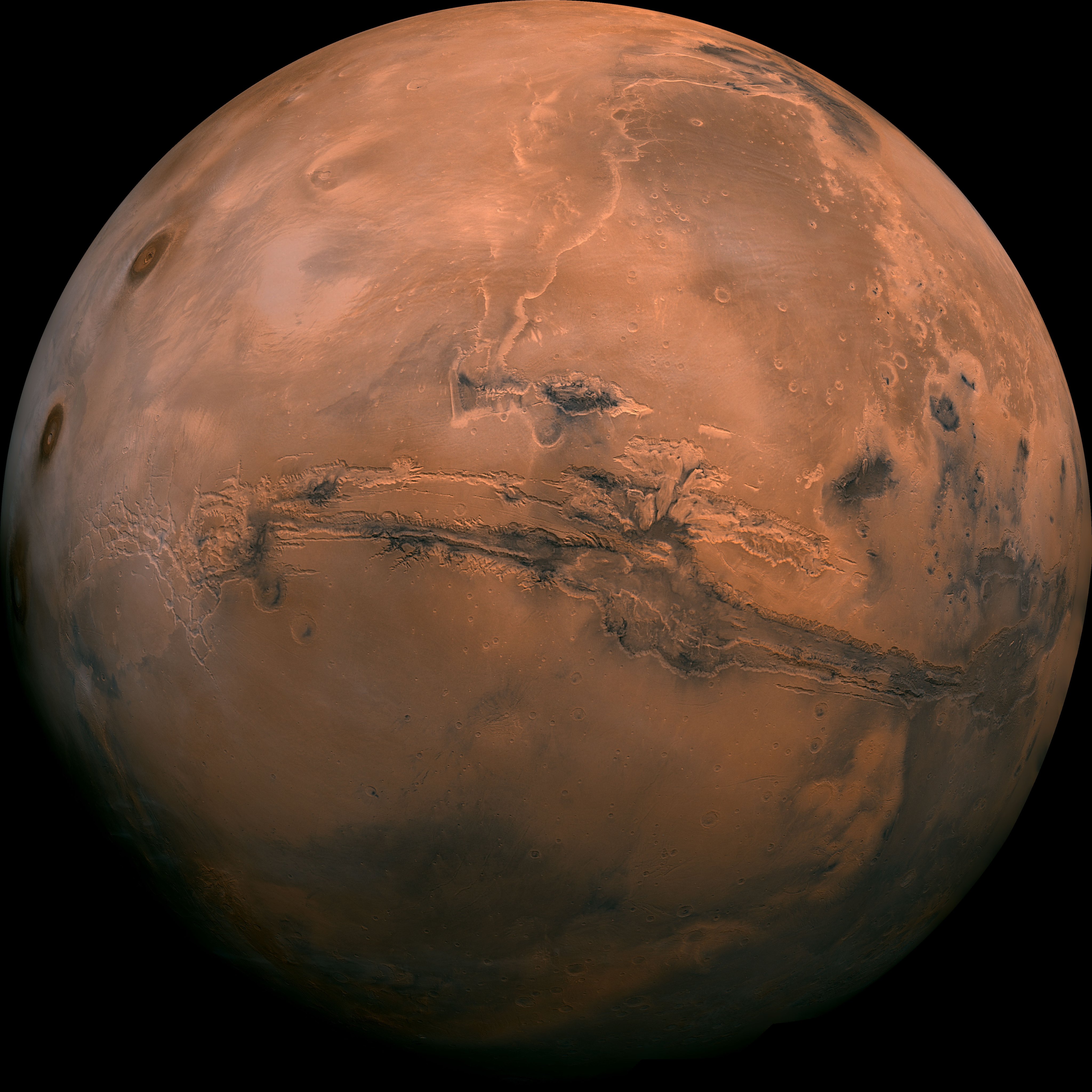9 min read

NASA’s Spitzer Space Telescope, designed to reveal the far, cold and dusty side of the universe, made discoveries its designers never even imagined, including quite a few in our own solar system. Here are 10 Spitzer science accomplishments in our own cosmic backyard:
Everyone knows Saturn has distinctive rings, but did you know its largest ring was only discovered in 2009, thanks to Spitzer?
Because this outer ring doesn’t reflect much visible light, Earth-based telescopes would have a hard time seeing it. But Spitzer saw the infrared glow from the cool dust in the ring.
The wispy structure is a diffuse collection of particles that orbit Saturn much farther from the planet than any of the other known rings. The ring starts about six million kilometers (3.7 million miles) away from the planet. It is about 170 times wider than the diameter of Saturn, and about 20 times thicker than the diameter of the planet. If we could see the ring with our eyes, it would be twice the size of the full Moon in the sky.
One of Saturn's farthest moons, Phoebe, circles within the ring and is likely the source of its material. The relatively small number of particles in the ring don't reflect much visible light, especially out at Saturn's orbit where sunlight is weak, which is why it remained hidden for so long. Spitzer was able to detect the glow of cool dust in the ring, which has a temperature of about minus 316 degrees Fahrenheit (minus 193 degrees Celsius,; or 80 Kelvin).

When NASA's Deep Impact spacecraft intentionally smashed into comet Tempel 1 on July 4, 2005, it expelled a cloud of material that contained the ingredients of our solar system's primordial "soup." Combining data from Deep Impact with observations by Spitzer, astronomers analyzed that soup and began to identify the ingredients that eventually produced planets, comets and other bodies in our solar system.
Many of the components identified in the comet dust were known ingredients, such as silicates, or sand. But there were also surprises, such as clay, carbonates (found in seashells), iron-bearing compounds and aromatic hydrocarbons like those are found in barbecue pits and automobile exhaust on Earth. The study of these ingredients provides valuable clues about the formation of our solar system.
Read more: How to Make Comet Soup
In June 2013, Spitzer’s Infrared Array Camera watched carbon dioxide slowly and steadily "fizzing" away from Comet ISON, the so-called "soda-pop comet," along with dust, in a tail about 186,400 miles (300,000 kilometers) long.
"We estimate ISON is emitting about 2.2 million pounds (1 million kilograms) of what is most likely carbon dioxide gas and about 120 million pounds (54.4 million kilograms) of dust every day," Carey Lisse, leader of NASA's comet ISON Observation Campaign said in 2013. "Previous observations made by NASA's Hubble Space Telescope and the Swift Gamma-Ray Burst Mission and Deep Impact spacecraft gave us only upper limits for any gas emission from ISON. Thanks to Spitzer, we now know for sure the comet's distant activity has been powered by gas."
Comet ISON (officially known as C/2012 S1) was less than 3 miles (4.8 kilometers) in diameter, about the size of a small mountain, and weighed between 7 billion and 7 trillion pounds (3.2 billion and 3.2 trillion kilograms). ISON was believed to be inbound on its first passage from the distant Oort Cloud, a roughly spherical collection of comets and comet-like structures that exists in a space between one-tenth light-year and 1 light-year from the Sun. The comet broke apart during a close “sungrazing” pass by the Sun in November 2013.
NASA/JPL-Caltech
Spitzer's infrared vision allows it to study some of the most distant objects ever discovered. But this space observatory can also be used to study small objects closer to Earth.
In particular, Spitzer helped scientists identify and study Near-Earth Objects (NEOs). NASA monitors these objects to make sure none of them is on a collision course with our planet.
Spitzer is particularly useful for characterizing the true sizes of NEOs, because it detects infrared light radiated directly from the asteroids. By comparison, asteroids do not radiate visible light, but merely reflect it from the Sun; as a result, visible light may reveal how reflective the asteroid is, but not necessarily how large it is. Spitzer has been used to study many NEOs that are less than 110 yards (100 meters) wide.
Read More: Spitzer Spies an Odd, Tiny Asteroid
In 2013, scientists compiled more than 2 million Spitzer images collected over 10 years to create one of the most extensive maps of the Milky Way galaxy ever made.
Viewing the Milky Way is a challenge because dust blocks visible light, so entire regions of the galaxy are hidden from view. But infrared light can often penetrate dusty regions better than visible light, and reveal hidden sections of the galaxy.
Studies of the Milky Way using Spitzer data have provided scientists with better maps of the galaxy's spiral structure and its central "bar" of stars. Spitzer has helped discover new remote sites of star formation, and has revealed a higher abundance of carbon in the galaxy than expected.
In November 2017, scientists pointed Spitzer toward the object known as 'Oumuamua — the first known interstellar object to visit our solar system. 'Oumuamua was too faint for Spitzer to
detect when it looked more than two months after the object's closest approach to Earth in early September. But the "non-detection" put a new limit on how large the strange object can be.
The new size limit is consistent with the findings of a research paper that suggested outgassing was responsible for the slight changes in 'Oumuamua's speed and direction as it was tracked. Scientists concluded that the expelled gas acted like a small thruster gently pushing the object. That determination was dependent on 'Oumuamua being relatively smaller than typical solar system comets. (The conclusion that 'Oumuamua experienced outgassing suggested that it was composed of frozen gases, similar to a comet.)
"'Oumuamua has been full of surprises from day one, so we were eager to see what Spitzer might show," said David Trilling, lead author on the study and a professor of astronomy at Northern Arizona University. "The fact that 'Oumuamua was too small for Spitzer to detect is actually a very valuable result."
For 30 years, a large near-Earth asteroid wandered its lone, intrepid path, passing before the scrutinizing eyes of scientists armed with telescopes while keeping something to itself. The object, known as Don Quixote, whose journey stretches to the orbit of Jupiter, now appears to be a comet.
The discovery resulted from an ongoing project coordinated by researchers at Northern Arizona University, Flagstaff, using Spitzer. Through a lot of focused attention and a little luck, they found evidence of comet activity, which had evaded detection for three decades.
The results show that Don Quixote is not, in fact, a dead comet, as previously believed, but it has a faint coma and tail. This discovery implies that carbon dioxide and water ice might be present on other near-Earth asteroids, as well.
The implications have less to do with a potential impact, which is extremely unlikely in this case, and more with the origins of water on Earth. Impacts with comets like Don Quixote over geological time may be the source of at least some of it, and the amount on Don Quixote represents about 100 billion tons of water – roughly the same amount found in Lake Tahoe, Calif.
Read More: Comet Found Hiding in Plain Sight
Located 10.5 light-years away in the southern hemisphere of the constellation Eridanus, the star Epsilon Eridani, eps Eri for short, is the closest planetary system around a star similar to the early Sun. It is a prime location to research how planets form around stars like our Sun, and is also the storied location of the Babylon 5 space station in the television series of the same name.
Studies indicated that eps Eri, also known as Ran, has a debris disk, likely comprised of tiny grains of rocky dust and ices generated by collisions of small bodies like asteroids and comets. Debris disks can be broad, continuous disks or concentrated into belts of debris, similar to our solar system’s asteroid belt and the Kuiper Belt – the region beyond Neptune where hundreds of thousands of icy-rocky objects reside.
In one of the most comprehensive multi-observatory galaxy surveys yet, astronomers found galaxies like our Milky Way underwent a stellar “baby boom,” churning out stars at a prodigious rate, about 30 times faster than today.
Our Sun, however, is a late bloomer. The Milky Way’s star-birthing frenzy peaked 10 billion years ago, but our Sun was late for the party, not forming until roughly 5 billion years ago. By that time the star formation rate in our galaxy had plunged to a trickle.
Missing the party, however, may not have been so bad. The Sun’s late appearance may actually have fostered the growth of our solar system’s planets. Elements heavier than hydrogen and helium were more abundant later in the star-forming boom as more massive stars ended their lives early and enriched the galaxy with material that served as the building blocks of planets and even life on Earth.
Rather than circling Earth, as Hubble does, Spitzer orbits the Sun on almost the same path as Earth. But Spitzer moves slower than Earth, so the spacecraft drifts farther away from our planet each year.
This “Earth-trailing orbit” has many advantages. Being farther from Earth than a satellite, it receives less heat from our planet and enjoys a naturally cooler environment. Spitzer also benefits from a wider view of the sky by orbiting the Sun.
While its field of view changes throughout the year, at any given time it can see about a third of the sky. NASA’s Kepler space telescope, famous for finding thousands of exoplanets – planets outside our solar system – settled in an Earth-trailing orbit six years after Spitzer.
Read More: Clever Choice of Orbit







